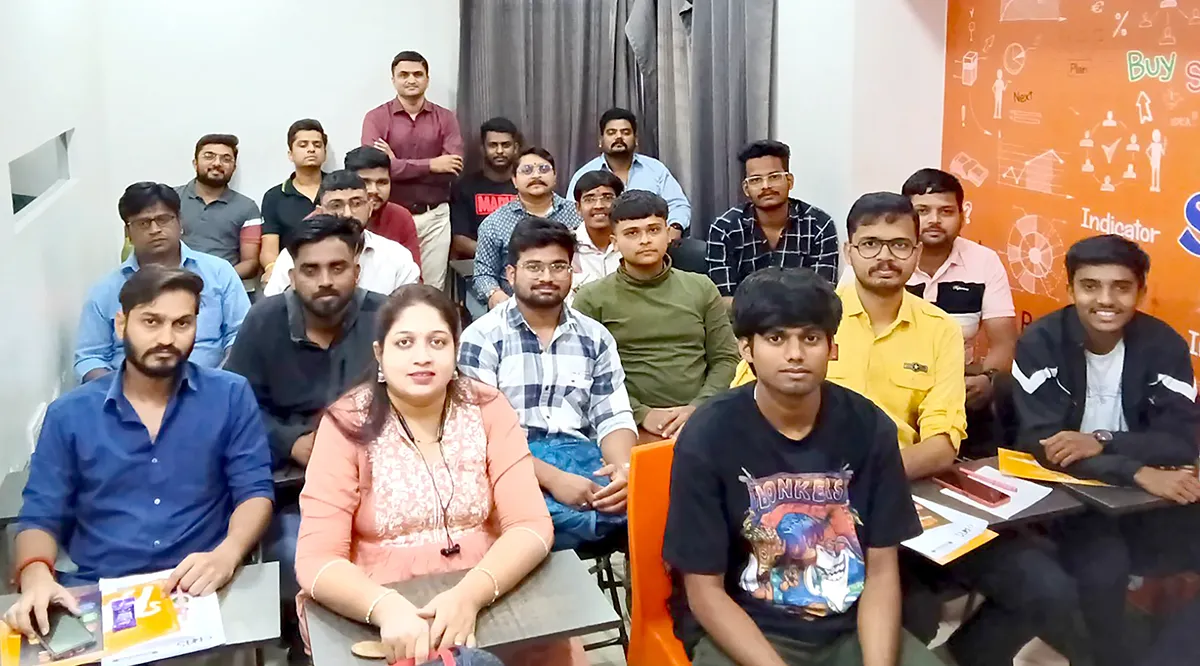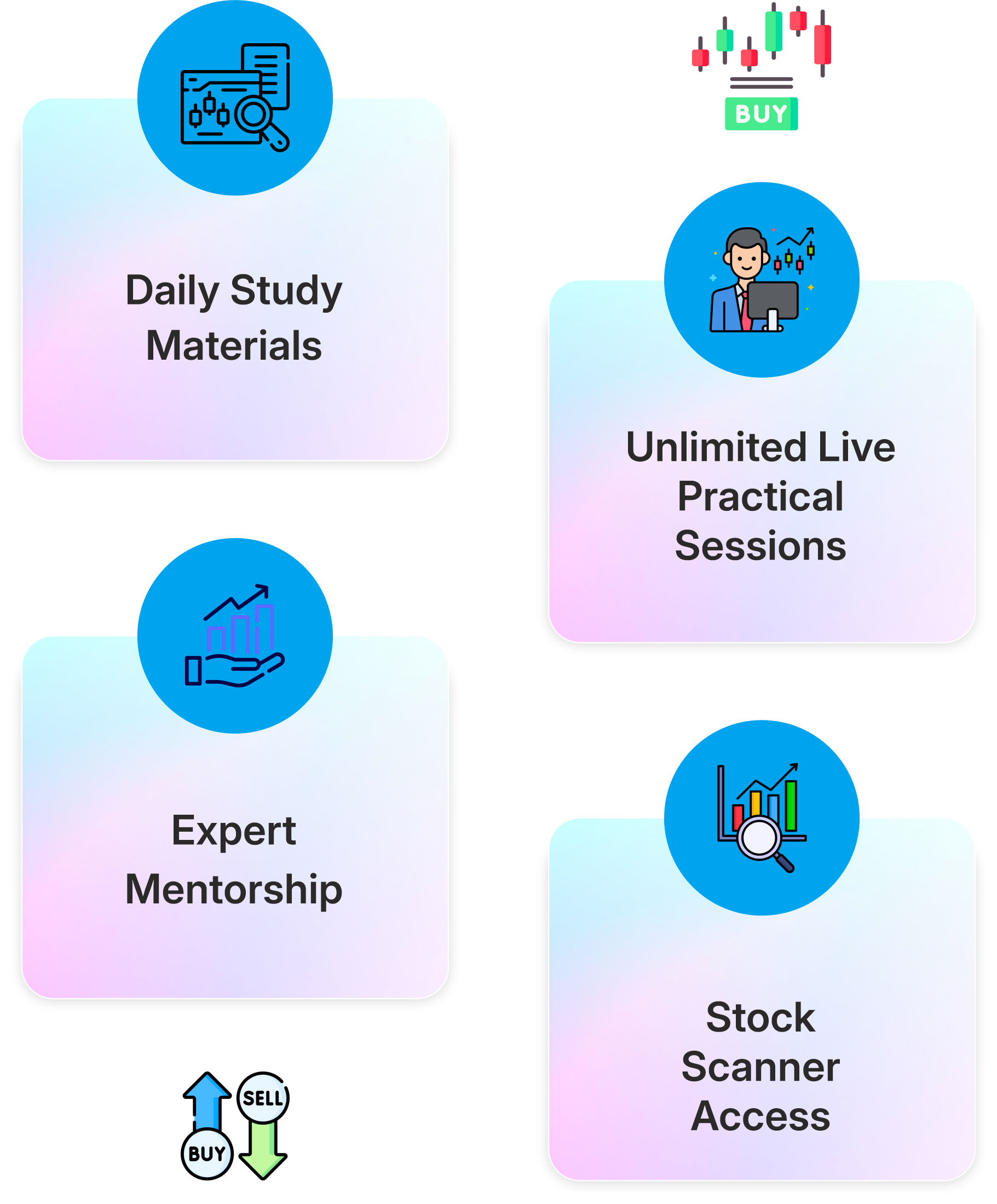


Finearn Stock Market Classroom Classes Basic to Advance Single Masterclass Syllabus
Gain real-world trading experience in our offline stock market classes Upgrade your stock market skills with Finearn Pune's offline share market classes!
Read More
Learn everything from basics to advanced strategies in one super course, with lifetime support and endless practice included. Invest in a course that delivers real results!
Why Sign Up For Finearn Offline Share Market Classes
Join Finearn Share Market Institute with offline stock market courses from experienced stock market professionals. Learn the basics you need to know, plus advanced tricks the pros use.
Read More
Learn from live strategy sessions, get one-on-one coaching and access helpful guides. Our course is designed for your busy life, with flexible schedules & lifetime support to keep you on track.
Module - 1 : Share Market Foundation
- Stock Market Basics (NSE/BSE History)
- Indian Retail Investors & Market Growth
- Leveraging Opportunities in Markets
- Personal Finance & Goal Execution
- IPO Basics & Listing Process
- IPO Analysis & Selection Strategies
- Primary vs Secondary Markets
- Intraday (Daily Trading)
- Delivery (Long-Term Portfolio)
- Swing (Trend-Based Trading)
- Equity Market Rules
- Taxation, Penalties, Auctions
- NSDL/CDSL Roles
- Trading Terminologies
- Own Trading Styles
- NISM/NCFM Certifications & Careers
Module - 2 : Futures & Options (F&O)
- Futures Market
- Rules & Regulations
- Trading Stocks / Indices
- Equity VS Futures Comparison
- Margins, MTM, Risk-Reward Ratios
- Commodity Market (MCX)
- Scope & Key Benefits of Commodities
- Bullion, Metals, Energy Trading
- Lot Sizes & Trading Timings
- Market-Affecting Factors
- Options Market
- Call / Put Options
- Hedging (Non-Directional)
- Speculation (Directional)
- Option Chain Analysis
- Strike Price, Premium, Greeks
- Open Interest (OI), PCR
Module - 3 : Fundamental Analysis
- Financial Statements
- Key Ratios (P/E, ROE, Debt-Equity)
- Company Valuation Methods
- Corporate Actions
- Dividends, Bonus, Buybacks
- Economic Indicators & Impact
- Qualitative Analysis
- Stock Selection & Case Studies
- Finearn Ten Vector Points (Investment View)
Module - 4 : Mutual Funds & Portfolio Mgmt.
- What are Mutual Funds?
- Process & Structure of Mutual Funds
- Types & Categories of Mutual Funds
- Investment Methods
- SIP, SWP, STP, Lump Sum
- ELSS, NFO, ETF
- Mutual Fund Selection Strategies
- Age & Risk-Based Investing
- Portfolio Monitoring & Rebalancing
- Risk-Reward Assessment
- Finearn Smart Strategies
- Asset Allocation & Diversification
- Age/Income & Risk-Based Diversification
- Power of Compounding
Module - 5 : Technical Analysis & Research
- Basics of Technical Analysis
- Chart Reading Fundamentals
- Price Action Trading
- Trend Lines & Types
- Support / Resistance Analysis
- Chart & Candlestick Patterns
- Technical Indicators (Below)
- Lagging (e.g., Moving Averages)
- Leading (e.g., RSI)
- Trading Strategy Development
- Advanced TA Tools
Module - 6 : Strategy & Trading Psychology
- Trading Strategies
- Intraday, Swing, Delivery
- Options: Straddle, Strangle, Covered Calls
- Backtesting & Proprietary (Finearn) Techniques
- Emotional Control & Behavioral Finance
- Overcoming Biases
- Trading Journal & Mistake Analysis
- Risk-Reward & Stop Loss Importance
- Position Sizing
Module -7: Algo Trading & AI Stock Analysis
- Introduction to Algorithmic Trading
- Benefits & Limitations of Algo Trading
- How Algo Trading Works
- Key Markets for Algo Trading
- Strategy Automation
- Wealth-Building Algo Strategies
- AI Tools for Trading
- Designing AI Prompts
- AI-Powered Stock Analysis
Module - 8 : Live Market Practical's
- Trading Platform Hands-On
- Real-Time Order Execution
- Live Stock Screening
- Financial Health & Chart Analysis
- Live Doubt Sessions (1:1)
- Trading Do's & Don'ts
- Group Discussions & Q & A

Batch Timing
EVENING BATCH : 7 PM - 9:30 PM
( Live Practical Session Unlimited)
Duration
3 Weeks / 2 Hours Daily
Modules
Number of
Modules - 08
Practical's
Unlimited Pactical Session
Flexible Batch
Online & Offline Courses
Why select Finearn Stock Market Classroom Classes
Enroll in Finearn’s expert-led offline stock market course for complete learning from basics to advanced strategies.
Read More
Experience live strategy sessions, personalized mentoring, and access to physical resources in a structured, supportive environment. Learn, trade, and grow with Finearn Share Market Academy powered by EMS Stock Market Institute – Sign up today!
We Are No.1 Masterclass Share Market Academy
India’s Trusted Stock Market Institute
Unlimited Practical
Session
Get hands-on market experience with no limit on practice sessions to build real trading skills.
AI-Based Stock Selection
Learn how artificial intelligence is used to choose the right stocks based on smart data analysis.
Algo Trading Introduction
Understand the basics of automated trading and how algorithms can make trading faster and smarter.
Online & Offline Course Access
Learn at your convenience with both online sessions and offline classroom options.
Proven Strategies with Live Execution
Master tried-and-tested trading strategies and see them applied live in the real market.
Session-Wise Study Material
Access organized learning content tailored for each session to enhance step-by-step learning.
Trusted by 9000+ Learners
Join a large community of successful students who have benefited from this program.
Regular Updates & Market Exposure
Stay updated with the latest market trends and get real-time exposure to live trading environments.
Finearn with Best Share Market Courses In Pune Offering Free Services
Learn Share trading easily and efficiently with Finearn Share Market Classes! Our complimentary resources ensure that you maximize your course experience by applying the teachings in real life.
Read More
If you encounter difficulties or have questions, our expert mentors are available to offer support whenever you need it.
Enjoy resources and study materials to learn at your pace. Finearn Share Market Academy, powered by FINEARN Stock Market Institute, offers expert-led trading education for aspiring investors.

Our Industry Expert Trainer
Why Finearn Share Market Classes is Pune's Best Choice?


FAQ's
You can enroll in our stock market classes, both online and offline, by paying a simple Rs 1000 enrollment fee and attending one session. If you find it unsuitable for any reason, we offer a full refund without any questions asked.
The fee for classroom classes is Rs 10,000, and for online classes, it is Rs 8,000. Discounts and special offers may apply under certain conditions.
We are the oldest share market institute in Pune and we have highly qualified trainers who are stock market experts. We teach copyrighted strategies to help you succeed in the market.
You can enroll in our stock market classes, both online and offline, by paying a simple Rs 1000 enrollment fee and attending one session. If you find it unsuitable for any reason, we offer a full refund without any questions asked.
The fee for classroom classes is Rs 10,000, and for online classes, it is Rs 8,000. Discounts and special offers may apply under certain conditions.
We are the oldest share market institute in Pune and we have highly qualified trainers who are stock market experts. We teach copyrighted strategies to help you succeed in the market.
Both online and offline classes will include 5-day funda-mental, 5-day technical, and 5-day strategy sessions. Following this, practical sessions will be unlimited until you gain a comprehensive understanding.
The Basic to Advance Single Masterclass includes advanced content, eliminating the need for additional advanced classes.
No. Upon completing the stock market course with us, you will receive complimentary trading tools and advisory services.
We offer stock market classes from basic to advanced, conducted in a mix of Hindi and English.
Anyone with an interest in the share market, eager to learn, earn, and succeed, is welcome to join.
We offer lifetime support to those who complete the basic to advanced course.
No prior knowledge of the stock market is necessary, though any existing knowledge would be beneficial.
You can use any device, such as a mobile phone, laptop, or tablet, for both the course and trading purposes.
We offer a variety of learning formats to suit your needs, including offline classroom classes, online share market classes learning modules, and recording share market classes.
Yes. upon successful completion of our stock market courses, you will receive a certificate of completion from Finearn Stock Market Institute.
We accept various payment options for your convenience, including and bank transfers, gpy, phone pay We offer installment plans for our courses. Please get in touch with our admissions advisor for details.
For classroom sessions, we offer recordings or alternative arrangements to ensure you don't miss out on the material. For online courses, you can revisit modules at your convenience.
No prior experience is needed. Our stock market class is beginner-friendly and starts with the basics. Whether you're a student, working professional, or homemaker, you'll be guided step-by-step to understand market concepts and trading
techniques.
Request A Call Back
Just submit your mobile number and we’ll be in touch shortly.







